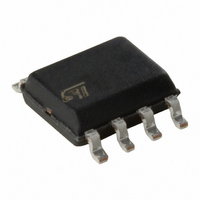M41T56M6E STMicroelectronics, M41T56M6E Datasheet - Page 8

M41T56M6E
Manufacturer Part Number
M41T56M6E
Description
IC SRAM SRL TIMEKPR 512BIT 8SOIC
Manufacturer
STMicroelectronics
Type
Clock/Calendar/NVSRAMr
Specifications of M41T56M6E
Memory Size
56B
Time Format
HH:MM:SS (24 hr)
Date Format
YY-MM-DD-dd
Interface
I²C, 2-Wire Serial
Voltage - Supply
4.5 V ~ 5.5 V
Operating Temperature
-40°C ~ 85°C
Mounting Type
Surface Mount
Package / Case
8-SOIC (3.9mm Width)
Function
Clock/Calendar
Rtc Memory Size
64 Byte
Supply Voltage (max)
5.5 V
Supply Voltage (min)
4.5 V
Maximum Operating Temperature
+ 85 C
Minimum Operating Temperature
- 40 C
Mounting Style
SMD/SMT
Rtc Bus Interface
Serial (2-Wire, I2C)
Nvram Features
RTC, Internal Battery, XTAL
Interface Type
I2C, Serial, 2-Wire
Supply Voltage Range
4.5V To 5.5V
Memory Case Style
SOIC
No. Of Pins
8
Rohs Compliant
Yes
Lead Free Status / RoHS Status
Contains lead / RoHS non-compliant
Other names
497-2818-5
M41T56M6
M41T56M6
Available stocks
Company
Part Number
Manufacturer
Quantity
Price
Part Number:
M41T56M6E
Manufacturer:
ST
Quantity:
20 000
2.1.3
2.1.4
2.1.5
8/25
Stop data transfer
A change in the state of the data line, from Low to High, while the clock is High, defines the
STOP condition.
Data valid
The state of the data line represents valid data when after a start condition, the data line is
stable for the duration of the High period of the clock signal. The data on the line may be
changed during the Low period of the clock signal. There is one clock pulse per bit of data.
Each data transfer is initiated with a start condition and terminated with a stop condition.
The number of data bytes transferred between the start and stop conditions is not limited.
The information is transmitted byte-wide and each receiver acknowledges with a ninth bit.
By definition, a device that gives out a message is called “transmitter,” the receiving device
that gets the message is called “receiver.” The device that controls the message is called
“master.” The devices that are controlled by the master are called “slaves.”
Acknowledge
Each byte of eight bits is followed by one Acknowledge Bit. This Acknowledge Bit is a low
level put on the bus by the receiver, whereas the master generates an extra acknowledge
related clock pulse.
A slave receiver which is addressed is obliged to generate an acknowledge after the
reception of each byte. Also, a master receiver must generate an acknowledge after the
reception of each byte that has been clocked out of the slave transmitter.
The device that acknowledges has to pull down the SDA line during the acknowledge clock
pulse in such a way that the SDA line is a stable Low during the High period of the
acknowledge related clock pulse. Of course, setup and hold times must be taken into
account. A master receiver must signal an end-of-data to the slave transmitter by not
generating an acknowledge on the last byte that has been clocked out of the slave. In this
case, the transmitter must leave the data line High to enable the master to generate the
STOP condition.
Figure 4.
CLOCK
DATA
Serial bus data transfer sequence
CONDITION
START
DATA VALID
DATA LINE
STABLE
DATA ALLOWED
CHANGE OF
CONDITION
STOP
AI00587













